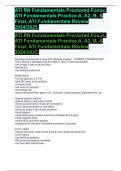ATI RN Fundamentals Proctored Focus,
ATI Fundamentals Practice A, A2, B, &
Final, ATI Fundamentals Review
2024/2025.
ATI RN Fundamentals Proctored Focus,
ATI Fundamentals Practice A, A2, B, &
Final, ATI Fundamentals Review
2024/2025.
Discharge teaching for a client with diabetes mellitus: - CORRECT ANSWER DIET:
-limit calories & decrease total fat intake to 30% of total calories/day
-eat omega 3 fatty acids and fiber
-low sat fats
-use artificial sweetners
WHEN SICK:
-monitor glucose Q 3-4 hr
-take DM meds as prescribed
-increase fluids
-test urine for ketones
-encourage rest
-report persistent fever above 101, confusion, rapid breathing, persistent N/V, etc.
-assess support systems
-assess ability to self-admin insulin
-check glucose before meals and at bedtime
-return demonstrations on self admin
-store test strips in dry closed container
-hand hygiene
-continuous pump needles need to be changed Q 2-3 days
-rotate injection sites
-record I&Os and daily weights
-hypoglycemia warrants immediate evaluation of glucose
FOOT CARE:
-inspect feet daily, wash w/mild soap & warm water-test temp first
-avoid lotions
-use mild foot powders
-NO home corn/callous remedies
-nail care after bath/shower
,ATI RN Fundamentals Proctored Focus,
ATI Fundamentals Practice A, A2, B, &
Final, ATI Fundamentals Review
2024/2025.
-avoid open toe or open heel shoes
-leather shoes better
-no barefoot
-cotton or wool socks
-water heater should be no more than 120
Client safety: fall risk precautions - CORRECT ANSWER -complete fall risk assessment
upon admission
-show client how to use call light, make sure it is within reach
-ensure adequate lighting
-orient the client to the setting, make sure they know how to use all assistive devices
-place fall risk clients near nurses station
-bedside tables, overbed tables, and frequently used items should be within reach
-bed in lowest position
-sedated/unconscious clients bed rails up, bed in lowest position
-avoid use of full side bed rails for clients who get out of bed or attempt to w/out
assistance
-nonskid footwear & nonskid bathmats
-keep floor free from clutter (no rugs, cords, furniture)
-educate family & client on fall risk status/prevention
-lock wheels on beds, wheelchairs, & cartss
-use chair & bed sensors
Home safety: Teaching an older adult client about home safety - CORRECT ANSWER -
remove items that could cause the client to trip (rugs, cords, carpets)
-place electrical/extension cords against a wall behind furniture
-monitor gait/balance, provide aids PRN
-make sure steps/sidewalks are in good condition
-grab bars near toilet, tub, shower
-stool riser, toilet cushion
-nonskid bath mats/shower mats
-shower chair or bedside commode PRN
-ensure adequate lighting
-water heater 120
-no smoking if on oxygen, cotton stuff only, no heating oil or nail polish remover
-cook meat and fish fully, handle properly
Client safety: alternatives to restraints for a client who is confused - CORRECT
ANSWER -one to one care
-keep close to nurse's station
,ATI RN Fundamentals Proctored Focus,
ATI Fundamentals Practice A, A2, B, &
Final, ATI Fundamentals Review
2024/2025.
-low to the floor beds with mattress on the floors
-bed alarms
-rocking chair in the room
-relaxation techniques
-family stay with the patient
Hygiene: Bathing a client who has dementia - CORRECT ANSWER -assess client's
ability to help
-collect equipment & explain procedure, reassure, maintain their dignity
-apply gloves
-lock wheels on beds
-wash face first
-keep them covered
-shave in direction of hair
-brush teeth and hair often and gently
-do not need to bathe daily as their skin cannot take it
-reorient often
thorax, heart, and abdomen: appropriate technique for abdominal assessment: -
CORRECT ANSWER 1. Inspection
2. Auscultation
3. Percussion
4. Palpation
-urinate before abd assessment
-supine, knees slightly bent
Self-concept and sexuality: Providing client support following a mastectomy: -
CORRECT ANSWER -monitor anger, emotions
-encourage client to participate in care
-arrange support group or visit from someone in similar situation
-counseling
-discuss alternative means of sexual expression (hugging, cuddling)
-therapeutic communication
Mobility & Immobility: Appropriate use of crutches: - CORRECT ANSWER -do not alter
crutches after fitting
-follow prescribed crutch gait
-support body weight at the hand grips w/the elbows flexed at 30 degrees
-position crutches on the unaffected side when sitting or rising from a chair
, ATI RN Fundamentals Proctored Focus,
ATI Fundamentals Practice A, A2, B, &
Final, ATI Fundamentals Review
2024/2025.
-keep crutches 6 inches to the front and to the side of client when walking
-don't let crutches fit under the armpit - allow some space to avoid damage to skin or
nerves in axillae
Urinary elimination: preventing skin breakdown - CORRECT ANSWER -keep skin dry
and clean
-assess for signs of breakdown
-apply protective barrier creams
-implement bladder retraining programs
Mobility & Immobility: Preventing thrombus formation: - CORRECT ANSWER -avoid
pillows under knees or lower extremities
-avoid crossing legs
-avoid wearing tight clothes
-avoid sitting for long periods of time
-avoid massaging the legs
-use elastic stockings
-use compression devices (SCD, IPC)
-increase fluid intake
-avoid valsalva maneuver
-change positions often
-encourage ROM & leg exercises
Fluid imbalances: hypersomolar imbalance - CORRECT ANSWER -aka dehydration
-fluids: isotonic solutions such as LR or 0.9% sodium chloride NaCl
-blood transfusions
-encourage oral rehydration as tolerated
this results in:
-increased Hct
-increased serum elecs
-increased urine specific gravity
-antidiuretic hormone release
-aldosterone release
-increased thirst
Nasogastric Intubation & Enteral feedings: Unexpected findings - CORRECT ANSWER
-excoriation of nares & stomach
-coffee-ground or blood streaked drainage
-distention (caused by occlusion of tube)




